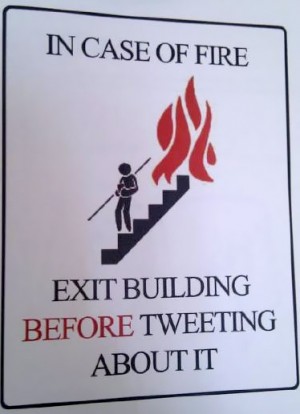Back in the days when “Web 2.0” was a hot buzzword, many people asked what “Web 3.0” would look like. Even though that question sounds now as outdated as an X-Files re-run episode, the quest for “what’s next?” is always in our minds. I’m no better prognosticator than anybody else, but my best answer would be: look at where the inefficiencies are. In no way is that a good indicator of what 2012 or 2013 will look like. Some inefficiencies may take decades to be properly addressed. But if you are trying to guess where we’ll see the next revolutionary step in social media–as opposed to the much-easier-to-predict incremental improvements–you have to focus where the biggest opportunities are, the undiscovered country somewhere out there. Analyzing the current landscape and the evolution of information markets by borrowing from a product life cycle framework may assist in developing some educated guesses about what the future may bring.
This is the third post in this current series discussing the differences between making and moving information and knowledge versus physical goods.
Since the first businessperson started bartering goods in some cave thousands of years ago, products went through a more or less standard life cycle: they were conceived, designed, produced, filtered for quality, distributed, sold, consumed, serviced, and finally disposed of. Over the course of history, that life cycle underwent several enhancements, most of them minor and mundane. A few of them, like the introduction of currency, steam power and the production line, had a huge impact in the overall efficiency of moving products around. Naturally, even though in retrospect those inventions seem like no-brainer milestones in the history of business and commerce, in reality their impact was scattered over a number of years. It’s likely that many who lived through those transitions did not realize how big those changes in fact were. One important indication of their revolutionary aspect is how each one of them enabled an incredible amplification in volume or reach of one or more stages of the product life cycle. Currency obviously made selling and trading more practical, steam power increased the ability to reduce the dependency on animals and people for mechanical work and the production line affected both the ability to manufacture better and to improve quality controls.
Non-physical items, such as ideas, information and knowledge, also go through a life-cycle of their own, but some of the steps are still not as sophisticated as the ones described above. Roughly speaking, that cycle consists of: creating, verbalizing (coding), capturing, distributing, filtering, consuming (decoding), and disposing of.
Creating and Coding
Thoughts and emotions come through everybody’s heads all the time, raw, unruly, uncensored. Then some are internally processed by the conscious mind and made sense of. A subset of those are mentally verbalized, and even a smaller portion of them is finally vocalized and communicated to others. The effect of technology in this early cycle has been modest. It still happens mostly the way it used to thousands of years ago.
Capturing
Capturing knowledge in the early days of humanity basically meant drawing on cave walls. Drawing became more elaborate with the advent of writing–which could be described as the codified doodling of one’s thoughts in an enduring medium–ensuring that a person’s knowledge could survive much beyond the physical constraints in time and space. More recently, photographs, movies, and audio recording permitted the capture of an increasing variety of information, but in practice they were still enabling us to more efficiently capture a concept, a memorable moment, or to tell a story.
Distributing
The introduction of movable type removed much of the limitations around the distribution of that content. Radio, cinema, TV, and the Internet of the 1990s did more of the same for a broader set of records of human knowledge. It was an expansion in scope, not in nature, but each new media added to the mix represented yet another powerful distribution amplifier.
Filtering and Consuming
All that capturing and distributing of information still relied a lot either on physical media or on the renting of expensive properties and expertise. Whole industries were created to exploit those high transaction costs. The inefficiencies of the system were one of the most powerful filtering mechanisms in that information life cycle. The big mass media players essentially dictated what was “media worth” for you to consume. In fact, that’s what most of us were known for: consumers of goods and information.
Disposing
Most information that is digitized today is not formally disposed of, it’s just abandoned or forgotten. Archived emails and SharePoint sites are an example of that, but how often do you search your company’s intranet and find information that is completely outdated and irrelevant now?
The social media role, so far
Much of what we call social media today, be it Internet forums, blogs, podcasts, photo, video and file sharing, social networks, or microblogging, along with the advances in mobile communications, contributed significantly to bring those transaction costs closer to zero. Billions of people can now not only capture and distribute information at low cost, but can also consume more of it and consume it faster. Not only that: the ability to add links to status updates, retweet, and share enabled regular people to filter and distribute content too. Everybody became a content curator and distributor of sorts, often without even realizing it.
So what’s next?
Most likely, we’ll continue to see an increasing sophistication of the inner steps of the information life cycle. We’re already witnessing better ways to capture (the IBM Smarter Planet initiative is a good example of that), filter (Google Plus’ circles), distribute (Tumblr, StumbleUpon) and consume (Flipboard, Zite) it. However, the obvious under-served stages in the information life cycle are the two extremities: creating, coding, and capturing on one side, and disposal of on the other.
On the creating, coding and capturing end, the major current inefficiency is loss of information. From the millions of ideas and thoughts that come to people’s minds, the vast majority vanishes without a trace. Twitter and status updates showed a very raw way of capturing some of that, but they are still cumbersome to use — and often impractical:

Apps like Evernote and Remember The Milk are evolving to make it much easier to record our impromptu thoughts, but the actual potential is enormous (suggested reading: The Future of Evernote). Even a real brain dump may be more feasible than most of us initially thought. As we learned a few days ago, UC Berkeley scientists have developed a system to capture visual activity in human brains and reconstruct it as digital video clips. The results are mesmerizing:
Reconstructing brain images into video
But it does not stop there. Ideas generate ideas. Capturing makes indexing and sharing possible. Imagine how much more knowledge could be created if we had better ways to share and aggregate atomic pieces of information. We might not like Facebook’s timeline and Open Graph real-time apps in their first incarnations, but they are just giving us a peek of what the future — and the past — may look like.
Decoding the existing content out there would be a good start. My first language being Portuguese, I often find amazing content in Brazilian websites or brilliant posts shared by my Portuguese-speaking colleagues that are still not easily consumable by most people in the world, making me wonder how much I’m missing for not knowing German, Chinese, Hindi, or Japanese. One can always argue that there are plenty of tools out there for translating Internet content. True, but the actual user-friendly experience would just be browsing websites or watching videos in Punjabi or Arabic without even noticing that they were originally produced in another language.
Finally, one of the unsolved problems of the information age is proper disposal of information. Since storage is so cheap, we keep most of what is created, and this is increasingly becoming an annoyance. I often wish that my Google search could default to limiting search to the last year or the last month only, as the standard results normally show ancient content that are no longer relevant to me. Also, most of us just accept that whatever we say online stays online forever, but that is just a limitation of our current technology. If we could for a second convert all that digital information to a physical representation, we would see a landfill of unwanted items and plenty of clutter. Of course, “disposal” in the digital world does not need to be complete elimination–could just be better ways to place things in the back burner or the backroom archive. For example, we could use sensorial clues of aging information. You always can tell if a physical book was freshly published or a print from 20 years ago, based on its appearance and smell. Old internet content could be shown with increasingly yellow and brown background tones, so that you could visually tell the freshness of content.
Some of the above sounds crazy and superfluous, but the idea of Twitter probably sounded insane not even 10 years ago. Are we there yet? Not even close. But that is what makes this journey even more interesting: what is coming is much more intriguing that what we saw so far. Like I said before, we’re still witnessing the infancy of social technologies.




